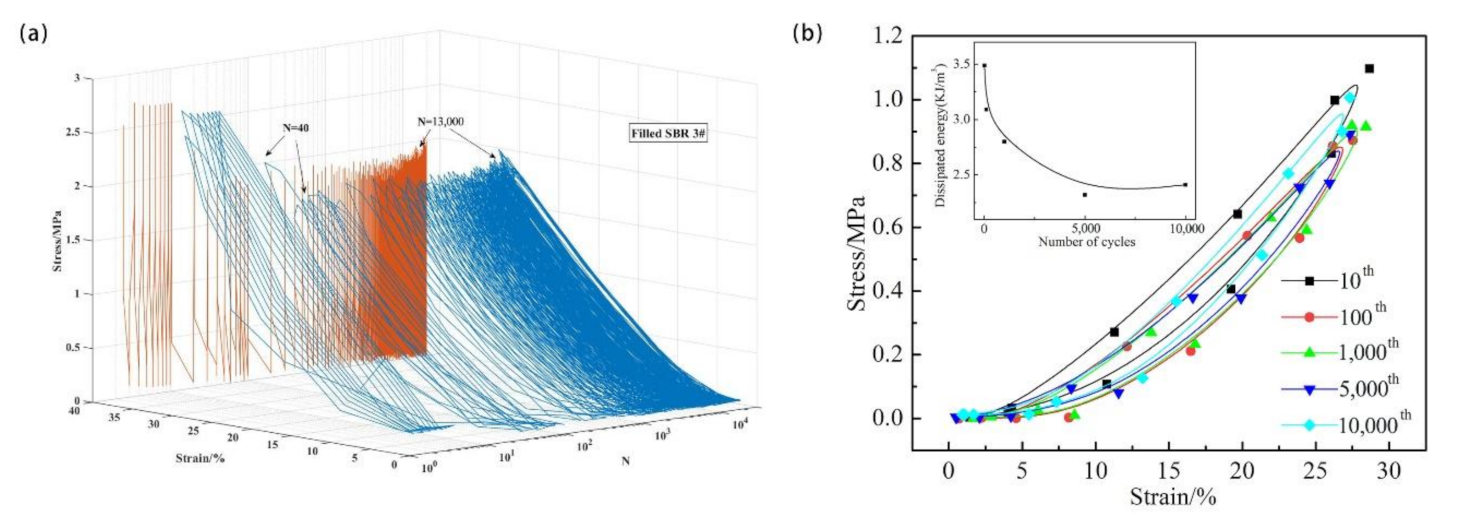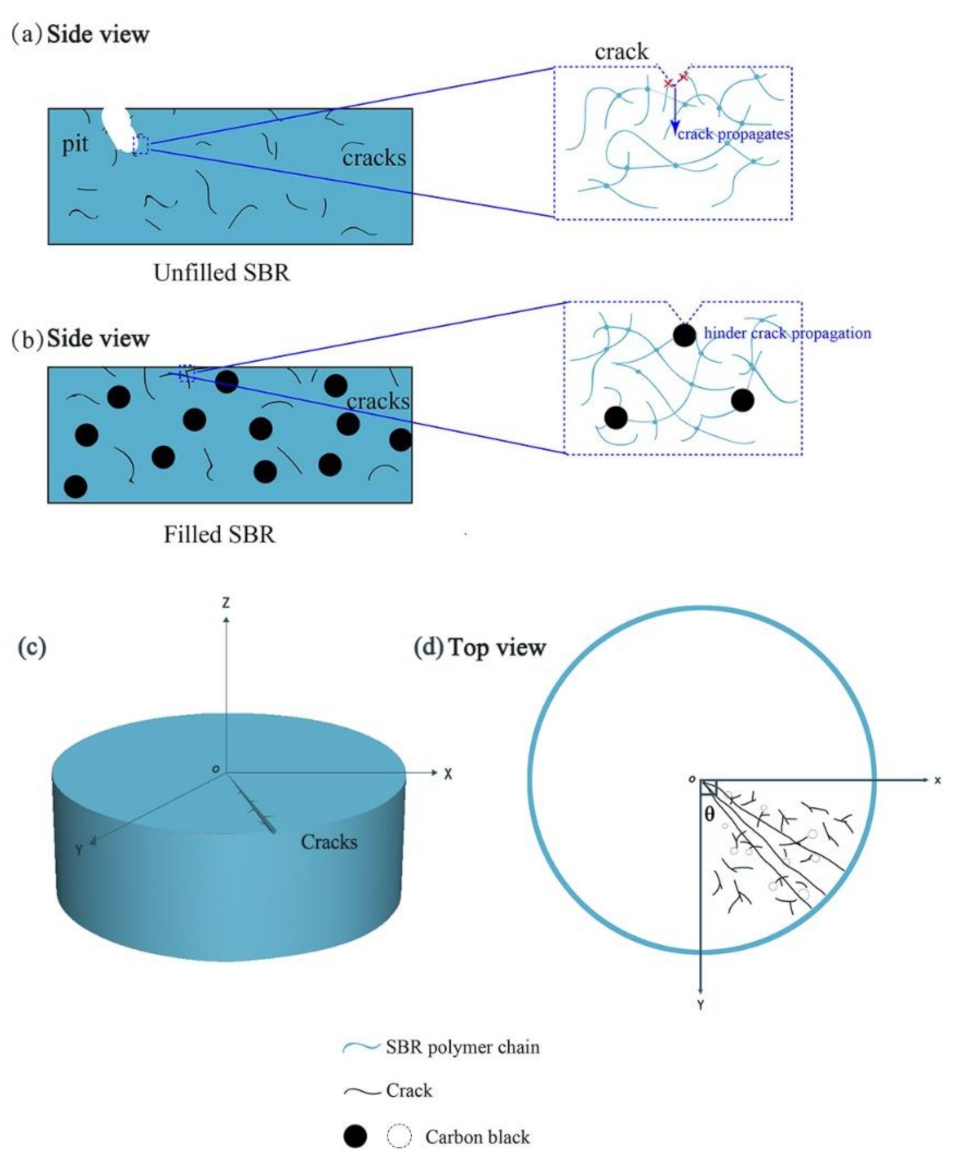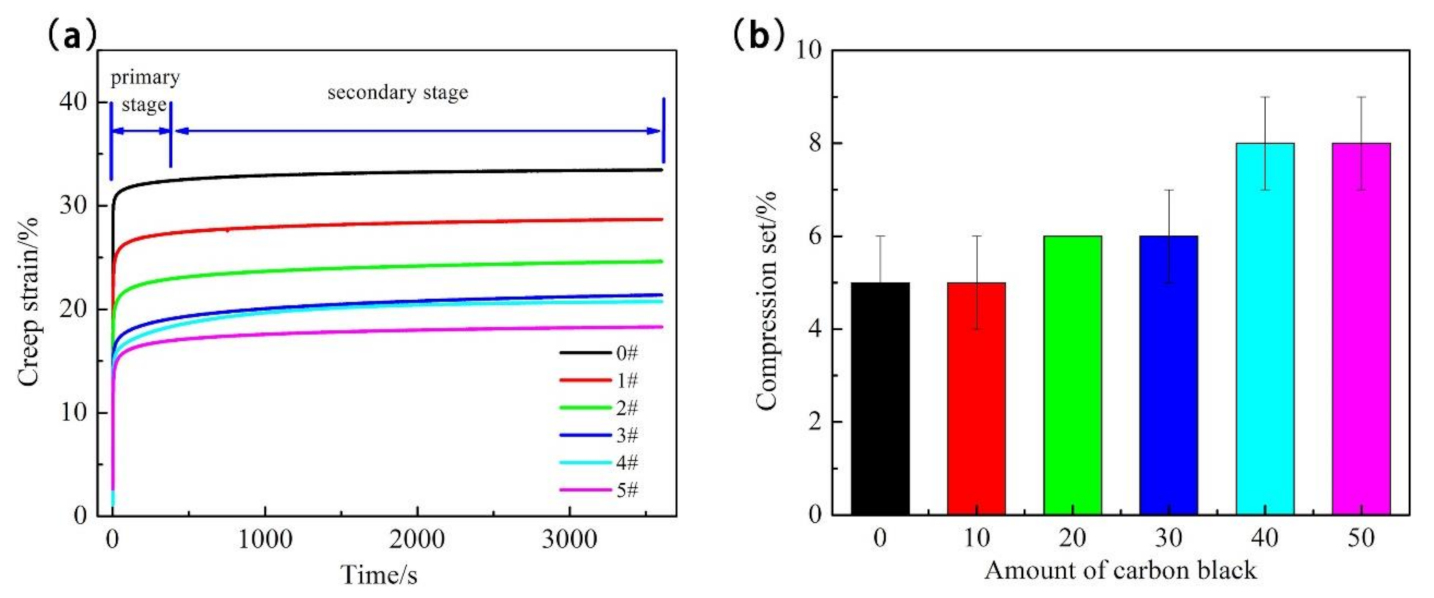Compressive Fatigue Behavior of Gum and Filled SBR Vulcanizates
Abstract
:1. Introduction
2. Materials and Methods
3. Results
3.1. The Effects of Carbon Black Content on the Curing Characteristics of the Compounds
3.2. The Effects of Carbon Black Content on the Mechanical Properties and Fatigue Life of the Vulcanizates
3.3. Cyclic Stress–Strain Behavior
3.4. Surface Morphology before and after Dynamic Compression Fatigue
3.5. Compressive Creep Behavior
4. Discussion
- (1)
- Along with increasing the carbon black content, the curing rate index (CRI) increases, which means carbon black has a positive effect on the curing rate. When the amount of carbon black is 30 phr, SBR vulcanizates show the best reinforcing properties. The magnitude of creep strain decreases with an increase of carbon black content, but the compression set of all the samples increases with increasing filler content.
- (2)
- When the samples are exposed to cyclic loading, the maximum stress is reduced due to the stress-softening effect at the first stage. At the second stage, the maximum stress decreases sharply and then reaches a plateau. Finally, maximum stress increases again, which is regarded as Nf. It is observed that carbon black can prolong the Nf. However, the content of carbon black has an optimal value of 30 phr.
- (3)
- The dissipated energy and the temperature rising gradually increases with increasing the content of carbon black. Since the temperature is difficult to transfer, the temperature in the middle part of the sample is the highest.
- (4)
- For filled SBR, massive cracks appear on the top surface. However, with the content of carbon black increasing, the damage of the vulcanizate alleviates.
Author Contributions
Funding
Institutional Review Board Statement
Informed Consent Statement
Data Availability Statement
Conflicts of Interest
References
- Hakami, F.; Pramanik, A.; Ridgway, N.; Basak, A.K. Developments of rubber material wear in conveyer belt system. Tribol. Int. 2017, 111, 148–158. [Google Scholar] [CrossRef] [Green Version]
- Wang, C.; Hausberger, A.; Berer, M.; Pinter, G.; Grün, F.; Schwarz, T. An investigation of fretting behavior of thermoplastic polyurethane for mechanical seal application. Polym. Test. 2018, 72, 271–284. [Google Scholar] [CrossRef]
- Lou, W.; Zhang, W.; Jin, T. Stress-thermal oxidative aging behavior of hydrogenated nitrile rubber seals. Appl. Polym. Sci. 2018, 40714, 1–8. [Google Scholar] [CrossRef]
- Beurrot-Borgarino, S.; Huneau, B.; Verron, E.; Rublon, P. Strain-induced crystallization of carbon black-filled natural rubber during fatigue measured by in situ synchrotron X-ray diffraction. Int. J. Fatigue 2012, 47, 1–7. [Google Scholar] [CrossRef] [Green Version]
- Nicolas, C.; Oguzhan, O.; Edith, P.D. Strain-induced network chains damage in carbon black filled EPDM. Polymer 2019, 175, 329–338. [Google Scholar]
- Movahedi-Rad, A.V.; Keller, T.; Vassilopoulos, A.P. Modeling of fatigue behavior based on interaction between time- and cyclic-dependent mechanical properties. Compos. Part A Appl. Sci. 2019, 124, 105469. [Google Scholar] [CrossRef]
- Gehrmann, O.; Kröger, N.H.; Krause, M. Dissipated energy density as fatigue criterion for non-relaxing tensional loadings of non-crystallizing elastomers. Polym. Test. 2019, 78, 105953. [Google Scholar] [CrossRef]
- Wu, B.; Jin, H. Compressive fatigue behavior of compound concrete containing demolished concrete lumps. Constr. Build. Mater. 2019, 210, 140–156. [Google Scholar] [CrossRef]
- Lim, G.Y.; Bodjona, K.; Raju, K.P. Evolution of mechanical properties of flexible epoxy adhesives under cyclic loading and its effects on composite hybrid bolted/bonded joint design. Compos. Struct. 2018, 189, 54–60. [Google Scholar] [CrossRef]
- Seichter, S.; Archodoulaki, V.M.; Koch, T. Investigation of different influences on the fatigue behaviour of industrial rubbers. Polym. Test. 2017, 59, 99–106. [Google Scholar] [CrossRef]
- Seichter, S.; Archodoulaki, V.M.; Koch, T.W.; Fidi, W.; Holzner, A.; Robin, S. Survey of the crack growth approach for the fatigue life estimation of application-relevant rubbers. AIP Conf. Proc. 2016, 1779, 1–5. [Google Scholar]
- Zhan, Y.; Yan, N.; Fei, G.; Xia, H.; Meng, Y. Crack growth resistance of natural rubber reinforced with carbon nanotubes. J. Appl. Polym. Sci. 2020, 137, 48447. [Google Scholar] [CrossRef]
- Rattanasom, N.; Prasertsri, S. Mechanical properties, gas permeability and cut growth behaviour of natural rubber vulcanizates: Influence of clay types and clay/carbon black ratios. Ploym. Test. 2012, 30, 645–653. [Google Scholar] [CrossRef]
- Huang, S.; Pan, B.; Wang, Q. Study on the hardness and wear behavior of eco-friendly poly (butylenes Succinate)-based bamboo carbon composites. Arab. J. Sci. Eng. 2019, 44, 7997–8003. [Google Scholar] [CrossRef]
- Alaeddin, B.I.; Emin, B.; Ibrahim, M. Flexural fatigue damage analyses of recycled rubber-modified epoxy-based composites reinforced with alumina fibres. Fatigue Fract. Eng. Mater. Struct. 2018, 42, 959–971. [Google Scholar]
- Abraham, F.; Alshuth, T.; Jerrams, S. Dependence on mean stress and stress amplitude of fatigue life of EPDM elastomers. Plast. Rubber. Compos. 2001, 30, 421–425. [Google Scholar] [CrossRef]
- Prabhavale, O.; Mahata, D.; Nando, G.B. Phosphorylated cardanol prepolymer-grafted carboxylated styrene-butadiene rubber for better processing with enhancing silica filler dispersion. J. Appl. Polym. Sci. 2019, 136, 47528. [Google Scholar] [CrossRef]
- Tangudom, P.; Thongsang, S.; Sombatsompop, N. Cure and mechanical properties and abrasive wear behavior of natural rubber, styrene–butadiene rubber and their blends reinforced with silica hybrid fillers. Mater. Des. 2014, 53, 856–864. [Google Scholar] [CrossRef]
- Yan, N.; Xia, H.; Zhan, Y.; Fei, G. New insights into fatigue crack growth in graphene-filled natural rubber composites by microfocus hard-X-Ray beamline radiation. Macromol. Mater. Eng. 2013, 298, 38–44. [Google Scholar] [CrossRef]
- Liang, H.; Fukahori, Y.; Thomas, A.G. The steady state abrasion of rubber: Why are the weakest rubber compounds so good in abrasion? Wear 2010, 268, 756–762. [Google Scholar] [CrossRef]
- Chen, K.; Yu, J.; Liu, Y. Creep deformation and its correspondence to the microstructure of different polyester industrial yarns at room temperature. Polym. Int. 2018, 68, 555–563. [Google Scholar] [CrossRef]
- Wu, C.-C.; Chiou, Y.-C. Stress-Strain Response of Cylindrical Rubber Fender under Monotonic and Cyclic Compression. Materials 2019, 12, 282. [Google Scholar] [CrossRef] [PubMed] [Green Version]
- Yang, L.; Liu, K.; Du, A. The Effect of Network Structure on Compressive Fatigue Behavior of Unfilled Styrene-Butadiene Rubber. Adv. Mater. Sci. Eng. 2020, 2020, 1–9. [Google Scholar] [CrossRef] [Green Version]






| Ingredients | ESBR | ZnO | SA | 4010 NA | NS | S | N330 |
|---|---|---|---|---|---|---|---|
| Unfilled SBR | 100 | 5 | 2 | 2 | 1 | 2 | - |
| Filled SBR | 100 | 5 | 2 | 2 | 1 | 2 | Variable (10,20,30,40,50) |
| Samples | ML/dNm | MH/dNm | t10/min | t90/min | MH-ML/dNm | CRI/dNm·min−1 |
|---|---|---|---|---|---|---|
| 0 | 0.59 | 8.8 | 6.52 | 13.94 | 8.21 | 1.11 |
| 1 | 0.37 | 23.37 | 7.40 | 27.53 | 23.00 | 1.14 |
| 2 | 1.32 | 26.99 | 7.18 | 23.38 | 25.66 | 1.58 |
| 3 | 2.31 | 30.84 | 6.73 | 23.22 | 28.53 | 1.73 |
| 4 | 3.00 | 33.96 | 5.47 | 20.73 | 30.96 | 2.03 |
| 5 | 3.87 | 37.32 | 4.52 | 20.78 | 33.45 | 2.06 |
| Samples | 0 | 1 | 2 | 3 | 4 | 5 |
|---|---|---|---|---|---|---|
| Tensile strength/MPa | 1.72 ± 0.19 | 6.24 ± 1.29 | 11.62 ± 0.73 | 20.22 ± 0.67 | 21.93 ± 1.08 | 23.16 ± 0.57 |
| Elongation at break/% | 367 ± 32 | 436 ± 52 | 458 ± 4 | 502 ± 8 | 436 ± 10 | 420 ± 9 |
| Tear strength/kN·m−1 | 7.64 ± 1.30 | 11.59 ± 2.17 | 22.99 ± 4.87 | 23.59 ± 3.63 | 32.08 ± 4.41 | 27.99 ± 2.37 |
Publisher’s Note: MDPI stays neutral with regard to jurisdictional claims in published maps and institutional affiliations. |
© 2021 by the authors. Licensee MDPI, Basel, Switzerland. This article is an open access article distributed under the terms and conditions of the Creative Commons Attribution (CC BY) license (https://creativecommons.org/licenses/by/4.0/).
Share and Cite
Yang, L.; Wang, L.; Guo, H.; Du, A. Compressive Fatigue Behavior of Gum and Filled SBR Vulcanizates. Polymers 2021, 13, 1497. https://doi.org/10.3390/polym13091497
Yang L, Wang L, Guo H, Du A. Compressive Fatigue Behavior of Gum and Filled SBR Vulcanizates. Polymers. 2021; 13(9):1497. https://doi.org/10.3390/polym13091497
Chicago/Turabian StyleYang, Liu, Lin Wang, Huaiqing Guo, and Aihua Du. 2021. "Compressive Fatigue Behavior of Gum and Filled SBR Vulcanizates" Polymers 13, no. 9: 1497. https://doi.org/10.3390/polym13091497
APA StyleYang, L., Wang, L., Guo, H., & Du, A. (2021). Compressive Fatigue Behavior of Gum and Filled SBR Vulcanizates. Polymers, 13(9), 1497. https://doi.org/10.3390/polym13091497







